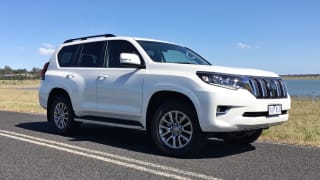
Toyota Prado 2018 review
The heavily updated Toyota LandCruiser Prado range sees some big changes for 2018, with a new look, updated interior and added equipment across most models in the range.
Browse over 9,000 car reviews

It's okay to admit it; you thought you'd never have been able to afford a Land Rover? Well now, for less than the price of a top-grade Toyota Kluger you can have a bottom-spec Discovery, which is the one we tested – the Discovery S Td4. Rejoice!
So what's the catch? Well, you'll have to read on to find out but let's just say that the Discovery S Td4 is quite basic, although our test vehicle was outfitted with a load of options that made it a bit more comfortable.
Still, even in its most basic form, this could be the best version of the Discovery to buy. We'll tell you why, and suggest a few options boxes you might want to tick.
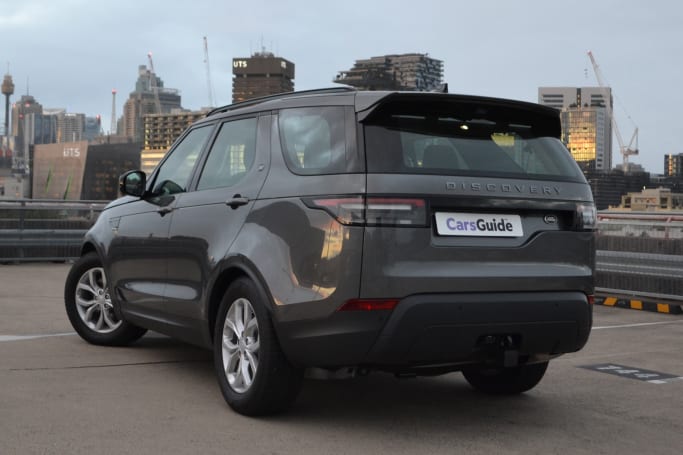
| Land Rover Discovery 2018: TD4 S | |
|---|---|
| Safety rating | |
| Engine Type | 2.0L turbo |
| Fuel Type | Diesel |
| Fuel Efficiency | 6.2L/100km |
| Seating | 5 seats |
| Price from | $48,400 |
When this fifth iteration of the Discovery arrived in 2016 its new, sleeker look had many fans of the big, boxy predecessor crying into their thermoses of billy tea.
Gone was the flat and square bonnet, the steep windscreen and large windows, and also consigned to the design bin of history was the old split-open tailgate.
The design team knew the new look would take people time to get used to; I know this because the head of the Discovery's crayon-wielders told me. He also noted that there was an uproar when they dared to introduce the split-open tailgate all those years ago, too.
There are a few design hat-tips to the earlier models which help this version retain its 'Discoveries', such as the stepped roofline and the number plate aligned left on the tailgate.
Enough people find the number-plate positioning so unpleasant that there are companies out there that sell kits to 'fix' the tailgate and position the plate more squarely in the centre.
Whether you love it or don't, this Discovery looks more like part of the larger Land Rover family, with a similar face to its Range Rover siblings.
Will the Discovery fit in your garage? Well it isn't small, but that's obvious. Looking at the Discovery's dimensions it is 4970mm long and 2073mm wide, with its wing mirrors folded out.

The height varies depending on whether you opt for the air suspension. Standard height is 1888mm to the top of the little shark-fin roof antenna. With the air suspension - which was fitted to our vehicle - you can lower the ride height by 40mm to an access level. Most multi-level parks are higher than 1.9m so you shouldn't have any issues, but it's best to get out and check if you're concerned.
The interior of the S is basic, with its cloth seats and dashboard devoid of any of the fancy trimmings you'll find in the higher grades. But to me there's an honest utilitarian aspect to it, because the Discovery, like the Defender, is supposed to be more workhorse than show pony. The last thing you want to worry about when you're out in the wilds is damaging the leather seats or having shiny aluminium dashboard trim glaring in your eyes.
Still this is a Land Rover, and this cabin still maintains enough of a premium look and feel, despite it being the base-grade car.
You might expect the Discovery S's interior to be super practical, but drop the word super and you're closer to the truth.
Our test vehicle had been optioned with the seven-seat package – you can see the costs for this and the other options fitted to it in the pricing section below.
Headroom is excellent throughout and so is legroom in the second and third rows. I'm 191cm tall and can sit behind my driving position with space to spare, and then behind that as well, without my knees digging into the seat back. Storage, however, isn't all that super.
You'll find a deep centre-console storage bin along with two cupholders up front and another two in the third row, plus covered storage boxes in the back seats, but the second row misses out on a fold-down armrest with cupholders, which comes on the higher grades. The second row also misses out on seat-back map pockets.
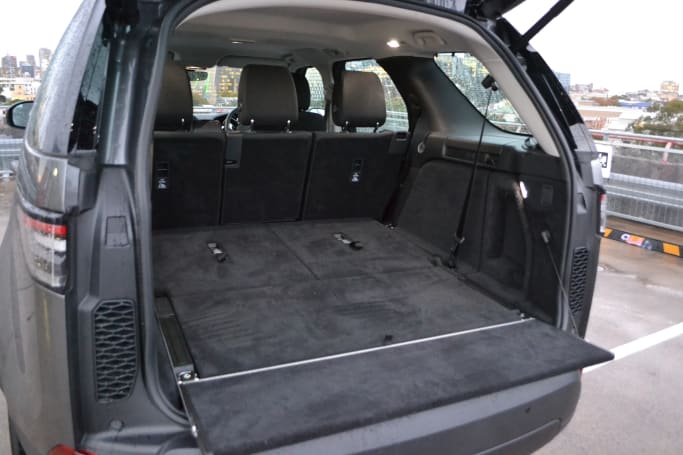
Higher grades come with a top and bottom-opening glovebox, but the S just has the lower part.
Boot space is 1137 litres with the third row folded flat and while this is big, the previous Discovery had 1260 litres of cargo room.
The air-suspension system lets you lower the rear of the Discovery to make loading easier.
An intriguing feature of in the boot is the fold-down shelf reminiscent of the earlier model's split tailgate. The obvious question, then, is why not just have a split tailgate?
Still, it's sturdy and acts as a good seat or table (perfect for watching the polo, apparently).
The S has one USB and one 12-volt power socket in the centre console, with another in the second row. Our test vehicle was optioned with two USB ports in the third row.
The roof rails on our car were also an option, see below for prices.
The Td4 S is the most affordable of the Discoverys, with a list price of $66,450. That price is very reasonable in relation to other SUVs from this brand, but the thing is you don't get much more than seats and a steering whee (and Land Rover badges). Okay, there is slightly more than that.
Coming standard is an eight-inch touch screen, with reversing camera, air-conditioning, cloth seats, leather steering wheel, 19-inch, 5 split-spoke alloy wheels and a full-sized spare wheel.
It's great that Land Rover offers the Discovery without any trimmings – I have hardcore Landy-loving, tweed-hat-wearing mates who'd get this variant in a flash because there are no powered seats that will stop working, or air suspension to sag in years to come, or other electronic bits to break.
Nope, frankly, this could well be the ultimate Discovery.
Well, perhaps not this specific one; ours was fitted with some options, which made the S a bit more comfortable and convenient, such as the 'Seven-Seat Pack', which includes a third row of two seats, plus air suspension and a power tailgate for ($5600); there was sat nav ($1610) too; and the 'Cold Climate Pack' with heated seats ($2500), the 'Vision Assist Pack' ($2700), which adds rain-sensing wipers and a surround -view camera, and roof rails $920.
Some of these options are overly expensive - the sat nav for instance – and items such as Apple CarPlay and Android Auto aren't offered at all.
Other options fitted included 'Corris Grey Metallic' paint ($2010), front parking sensors ($830) and a powered inner tailgate ($560).
As for rivals, you should also check out the Toyota Prado if you plan on taking a few off-road adventures, or if you're staying on the road there are the Volkswagen Touareg and Jeep Grand Cherokee, too.
The Td4 is a 2.0-litre turbo-diesel four-cylinder engine, making 132kW/430Nm. This 'Ingenium' engine, as it's known, arrived in 2017 and is acclaimed for its relatively high output and impressive fuel economy.
The torque is good but there is turbo lag at low revs, and I found myself using the paddle shifters to keep the eight-speed transmission in lower gears if I had to dart through traffic. And when I say dart, I'm being generous; this thing has a 0-100km/h time of 10.5 seconds and a top speed of 189km/h. Still, the Series 1 Discovery in 1991 packed a V8 and only made 115kW/260Nm, so things have come a long way.
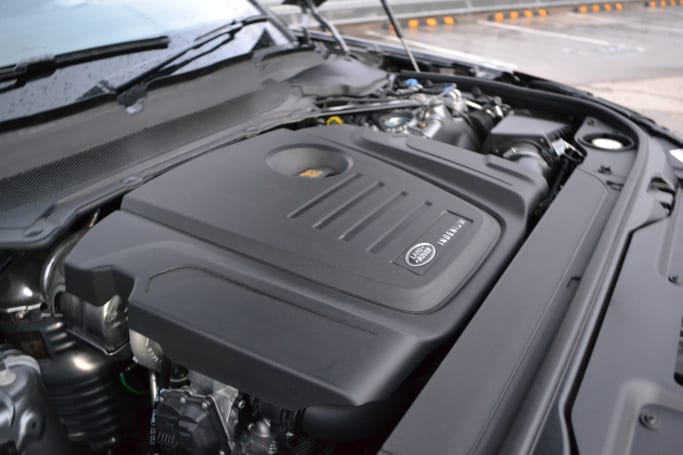
All Discoverys are four-wheel drive and while they no longer have the ladder-frame chassis of past models they are a capable off-road vehicle – some more than others, however. That's because the Td4 is not able to be fitted with an active rear locking differential, nor low range, nor the Terrain Response 2 system, which is optional on the Sd4 and Td6.
The Discovery S with the Td4 engine has an official fuel consumption of 6.2L/100km for the five-seat version and 6.3L/100km for the seven-seater; that figure is calculated after simulated urban and open-road driving. We did a real-world combination of close to 300km of motorways and city roads and the trip computer recorded an average of 10.1L/100km.
The Land Rover Discovery was awarded the maximum five-star ANCAP rating in 2017. Included as standard on even the base grade S we drove is AEB and lane-departure warning, along with traction and stability control, plus a suite of airbags - including curtain airbags, which cover the third row.
You'll find anchor points and mounts galore for child and baby seats with two ISOFIX ones and three top-tether style in the second row and two more ISOFIX points in the third row, along with two top tethers.
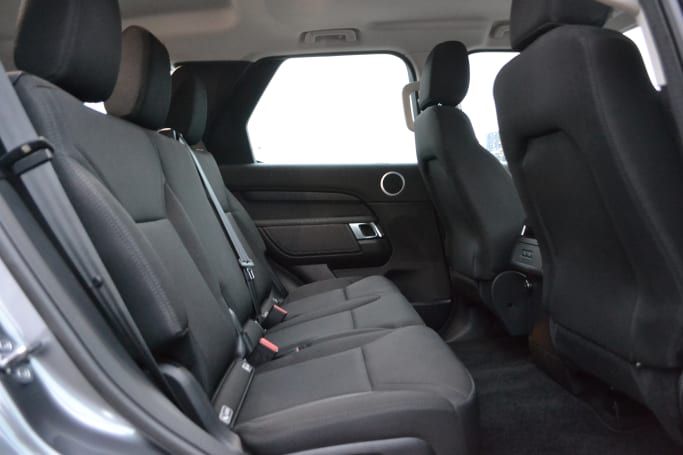
Basic Warranty
3 years / 100,000 km warranty
ANCAP Safety Rating

The Discovery is covered by Land Rover's three-year/100,000-kilometre warranty. Land Rover offers a fixed-price servicing plan for the Discovery and costs $1500 per visit for five years. Servicing is recommended every 12 months or 26,000km.
Air suspension is a bit like coffee; once you've lived with it, life without it can feel awful, and that's one of the reasons why I wish our test car had the coil springs that come standard on the Discovery S.
This would have given me a better insight into the base grade at its very 'basest'. But our car was fitted with the optional air suspension, which made the ride gloriously comfortable.
That plush ride, the smooth and slow-geared steering, the eight-speed auto, great brakes and the ride height made driving the Discovery S Td4 truly enjoyable.
The one point letting the experience down, in my view, is the Td4 engine. The 2.0-litre diesel is a great piece of machinery with its high torque and low thirst, but the turbo lag at low revs can leave you bogged down and reaching for the paddle shifters quickly to find a lower gear to get you moving.
It's worth noting that, despite the use of weight-saving materials, the Discovery S comes in at close to 2.2 tonnes. and more grunt would certainly help the SUV move quicker.
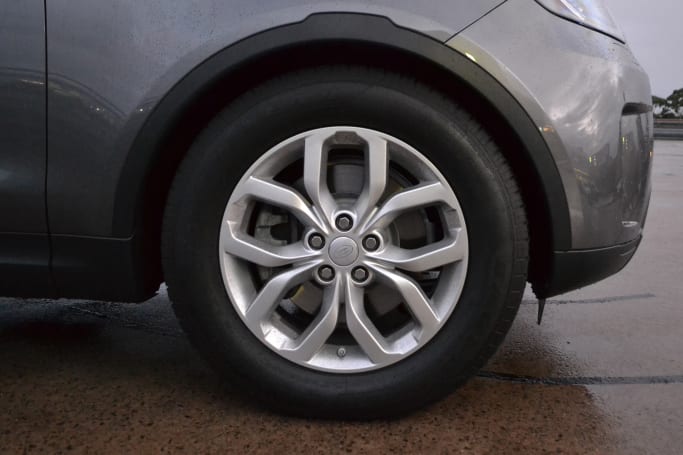
The 2.0-litre Sd4, with its sequential twin-turbo, or the much-beefier 3.0-litre Td6 would be more fun. If you were to step up to those engines you're looking at a price increase from the Td4's $66,450 to $72,050 for the Sd4 and $78,750 Td6.
Long and wide, the Discovery does feel large, especially in car parks, and while forward and side visibility are excellent, the view out the rear is obstructed by the tall headrests in the back, and that chunky C-pillar blocks vision, too.
We didn't have the opportunity, this time, to take the Discovery off-road, but as we've established, the Td6 and Sd4 are better equipped for tough terrain, with their standard high and low range, plus optional rear locking differential.
Still, even with just high-range 4WD, the Discovery S Td4 is more than competent, with a wading depth of 900mm, and its air suspension giving it a ground clearance of 283mm. Also excellent are the approach angle of 34.0 degrees, a departure angle of 30 degrees and a ramp angle of 27.5 degrees.
The Sd4 has a braked towing capacity of 3000kg.
The Discovery S with the Td4 engine doesn't come with a lot of equipment, but that is also its charm; simple, functional and capable. The optional air suspension is great, and the seven-seat package also makes it one of the roomiest people-carrying SUVs on the market. The Td4 engine isn't a deal breaker, but I'd knock back a few of these options and spend the money on an option with more grunt.
| Vehicle | Specs | Price* | |
|---|---|---|---|
| TD4 S | 2.0L, Diesel, 8 SP AUTO | $48,400 – 55,660 | 2018 Land Rover Discovery 2018 TD4 S Pricing and Specs |
| TD6 S | 3.0L, Diesel, 8 SP AUTO | $57,420 – 66,000 | 2018 Land Rover Discovery 2018 TD6 S Pricing and Specs |
| SD4 S | 2.0L, Diesel, 8 SP AUTO | $52,580 – 60,390 | 2018 Land Rover Discovery 2018 SD4 S Pricing and Specs |
| TD6 SE | 3.0L, Diesel, 8 SP AUTO | $71,940 – 82,720 | 2018 Land Rover Discovery 2018 TD6 SE Pricing and Specs |
| Design | 7 |
|---|---|
| Practicality | 8 |
| Price and features | 7 |
| Under the bonnet | 7 |
| Efficiency | 8 |
| Safety | 8 |
| Ownership | 7 |
| Driving | 7 |
$37,990
Lowest price, based on 19 car listings in the last 6 months